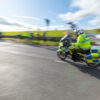UK Bikers: Is the Highway Code Making the Roads Any Safer?
For UK bikers, safety on the roads is a major concern. The Highway Code has been designed to help reduce the risk of accidents and improve road safety, but does it really make a difference? In this blog post, we will look at how the Highway Code affects the safety of UK bikers and ask the question: Is the Highway Code making the roads any safer for UK bikers?
What is the Highway Code?
The UK Highway Code is the official document outlining the rules of the road for drivers, riders, and other road users. The Code is designed to ensure safe and responsible use of our roads, and provides advice on issues such as parking, speed limits, and more. It also offers guidance on what to do in various situations, such as when driving in fog or encountering animals on the road. The Code was first published in 1931 and is regularly updated to keep up with changes in the law and technology. Bikers should be familiar with the Code and make sure they stay up-to-date with any amendments or updates.
Is it protecting bikers?
The UK Highway Code was updated on January 29th, 2021 with the introduction of several new rules designed to protect bikers and other vulnerable road users. The most important of these is the ‘Hierarchy of Road Users’ which places those at greater risk higher up in the order of priority. This means that drivers and riders should always give priority to pedestrians, even when they are waiting to cross the road.
For cyclists and horse riders, the Highway Code also outlines specific rules for how to safely pass them, such as cyclists being allowed to position themselves in the middle of the lane on minor roads and horse riders being given at least two metres passing space. There are also additional rules which stipulate that drivers must use dipped headlights when passing cyclists in order to make them more visible.
Overall, these new rules are designed to ensure that bikers, along with cyclists and horse riders, are given more protection while using the roads. These measures go a long way towards making the roads safer for bikers and other vulnerable road users.

How well is it enforced?
When it comes to enforcing the Highway Code, it can be difficult. There is no single enforcement agency that monitors all roads and highways in the UK, meaning that how strictly the code is followed will vary from place to place. In some cases, local authorities may employ traffic wardens or community safety officers who can issue fines or warnings to those who are not following the code.
On motorways and major trunk roads, enforcement is usually done by police officers or traffic officers. They may use fixed cameras and average speed cameras to check for compliance with the code, as well as roadside checks and patrols. They can also issue fines for offences such as speeding, tailgating and using a mobile phone while driving.
It is worth noting, however, that there is a degree of ambiguity when it comes to enforcing the Highway Code. Some offences, such as failing to give way when turning left, may be hard to spot and therefore difficult to prosecute.
In order for the Highway Code to be fully effective in keeping bikers safe on the roads, it is important that the code is enforced in a consistent and rigorous manner. Otherwise, bikers may be tempted to take risks or ignore the rules, leading to an increase in dangerous behaviour on the roads.
What can be done to make the roads safer for bikers?
One of the most important things that can be done to make the roads safer for bikers is to ensure that everyone follows the Highway Code. This includes bikers, drivers, and pedestrians alike. Motorcyclists should ensure that they are aware of the rules of the road and abide by them at all times. This includes ensuring that they wear appropriate protective gear and adhere to the speed limits.
Drivers also need to take extra care when sharing the roads with bikers. They should be aware of their surroundings and keep an eye out for motorcycles when changing lanes or turning corners. Additionally, it’s important to allow bikers plenty of space when passing and not overtake them too closely.
It’s also important for local authorities to take steps to improve infrastructure and road layouts, as these can help to reduce motorcycle accidents. For example, installing raised pedestrian crossings and dedicated bike lanes can help to protect motorcyclists from other road users. Furthermore, introducing better signage and improved street lighting can also help to keep bikers safe.
Finally, governments need to ensure that there is adequate enforcement of traffic regulations. This could include stiffer fines for those caught speeding or driving recklessly, as well as a greater number of traffic officers patrolling the roads.
By following the Highway Code, paying attention to the road environment, and taking steps to improve infrastructure, we can all help to make the roads safer for bikers.









